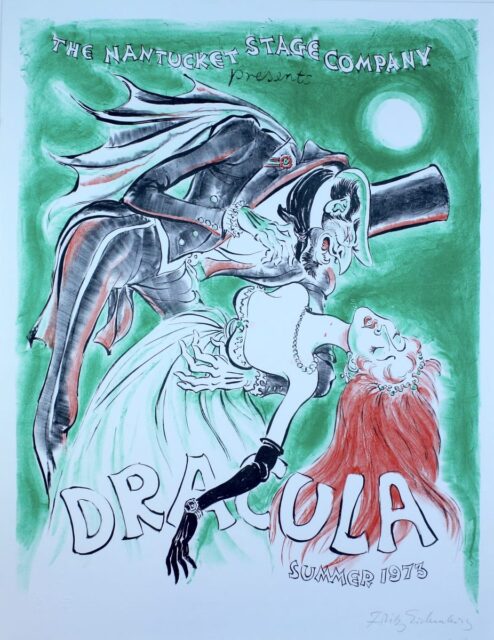Fritz Eichenberg (German-American, 1901-1990)
Dracula, 1973
Lithograph on paper
26 x 20 in
From candy and costumes to pumpkins and witches, Halloween is a frightfully fun day. What better way to celebrate this holiday than with a classic horror story?
Fritz Eichenberg’s Dracula is perfect for the spooky season. The piece is an old theater poster advertising for a performance of Dracula. Dracula is a gothic novel by Bram Stoker. Some believe the novel is based on a real-life version of Dracula named Vlad the Impaler, also known as Drăculea.
The moment I saw this piece, the sharp contrast between the vivid green background and the bright red of the woman’s hair drew me in. In this case, the red seems to mirror the importance of blood to a vampire. The red hair is also reflected on the suit of the vampire, maybe emphasizing his thirst for her blood. The eerie white moon in the background feels haunting, as does the shade of green. It felt perfect for a spooky day such as Halloween.
As I looked at the piece more I noticed how the swooping lines of the cape subtly resemble a bat’s wing. In the novel, Count Dracula appears as a normal man at first. The cape on the poster mirrors this, blurring the line between fantasy and reality: Is it actually a cape, or is it slowly transforming into a bat wing?
The contrast between Dracula and the woman is also striking. Dracula’s massive shoulders and thin waist emphasize his power as a supernatural being, appearing menacing and strong. His dark colored suit is jarring against the pale white of the woman’s dress. Dracula’s hands are long and knobby, almost skeletal. The position of his hand as it reaches out for the woman is threatening. In contrast, the woman’s hand is much more graceful and elongated.
The appearance of the woman’s neck also stood out to me. Her neck appears slightly elongated, almost as if it has a mind of its own, stretching closer to Dracula’s mouth. Two small, red dots are visible, suggesting the bites from vampire fangs.
The figures both feel very graceful. The position reminded me of a dance. The movement in the artwork feels very fluid, almost as if the woman was dancing with Dracula when all of a sudden his fangs appeared.
Eichenburg’s Dracula put me in the spooky spirit with its eerie colors and haunting characters. As you eat candy corn and put on your costume, lookout for vampires on this Halloween night.
Fritz Eichenburg (German-American, 1901-1990) was an illustrator, printmaker, and professor. He worked primarily in wood carving, centering around social satire, comedy, and conflict. Eichenburg studied at the Academy of Graphic Arts in Leipzig before working as a freelance illustrator. He immigrated to the United States in 1933.
– Natalie Fox ’27

